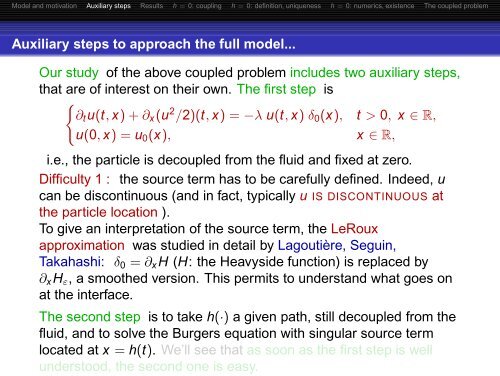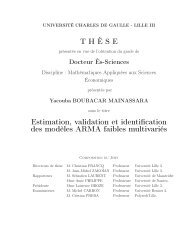A particle-in-Burgers model: theory and numerics - Laboratoire de ...
A particle-in-Burgers model: theory and numerics - Laboratoire de ...
A particle-in-Burgers model: theory and numerics - Laboratoire de ...
Create successful ePaper yourself
Turn your PDF publications into a flip-book with our unique Google optimized e-Paper software.
Mo<strong>de</strong>l <strong>and</strong> motivation Auxiliary steps Results h = 0: coupl<strong>in</strong>g h = 0: <strong>de</strong>f<strong>in</strong>ition, uniqueness h = 0: <strong>numerics</strong>, existence The coupled problem<br />
Auxiliary steps to approach the full <strong>mo<strong>de</strong>l</strong>...<br />
Our study of the above coupled problem <strong>in</strong>clu<strong>de</strong>s two auxiliary steps,<br />
that are of <strong>in</strong>terest on their own. The first step is<br />
<br />
∂tu(t, x)+∂x(u 2 /2)(t, x) = −λ u(t, x) δ0(x), t > 0, x ∈ R,<br />
u(0, x) = u0(x), x ∈ R,<br />
i.e., the <strong>particle</strong> is <strong>de</strong>coupled from the fluid <strong>and</strong> fixed at zero.<br />
Difficulty 1 : the source term has to be carefully <strong>de</strong>f<strong>in</strong>ed. In<strong>de</strong>ed, u<br />
can be discont<strong>in</strong>uous (<strong>and</strong> <strong>in</strong> fact, typically u IS DISCONTINUOUS at<br />
the <strong>particle</strong> location ).<br />
To give an <strong>in</strong>terpretation of the source term, the LeRoux<br />
approximation was studied <strong>in</strong> <strong>de</strong>tail by Lagoutière, Segu<strong>in</strong>,<br />
Takahashi: δ0 = ∂xH (H: the Heavysi<strong>de</strong> function) is replaced by<br />
∂xHε, a smoothed version. This permits to un<strong>de</strong>rst<strong>and</strong> what goes on<br />
at the <strong>in</strong>terface.<br />
The second step is to take h(·) a given path, still <strong>de</strong>coupled from the<br />
fluid, <strong>and</strong> to solve the <strong>Burgers</strong> equation with s<strong>in</strong>gular source term<br />
located at x = h(t). We’ll see that as soon as the first step is well<br />
un<strong>de</strong>rstood, the second one is easy.
















